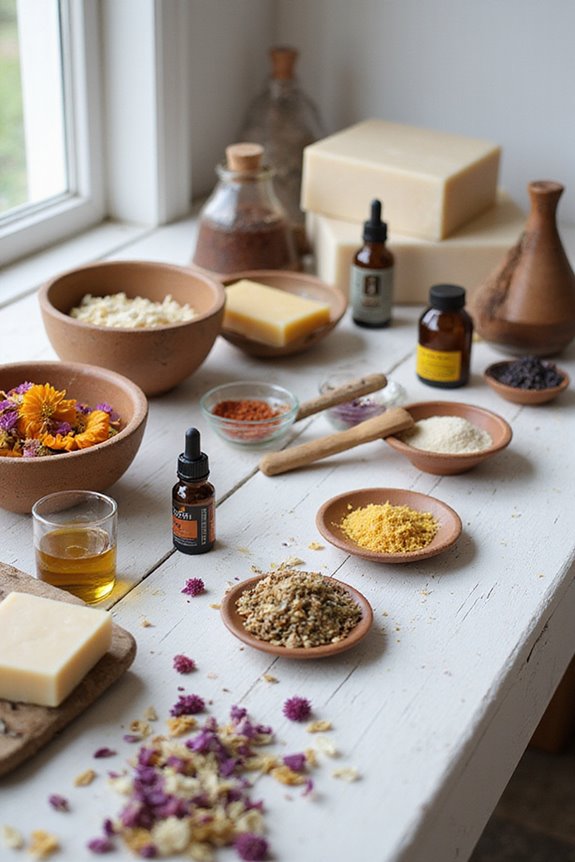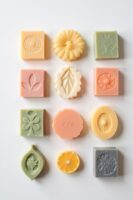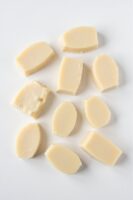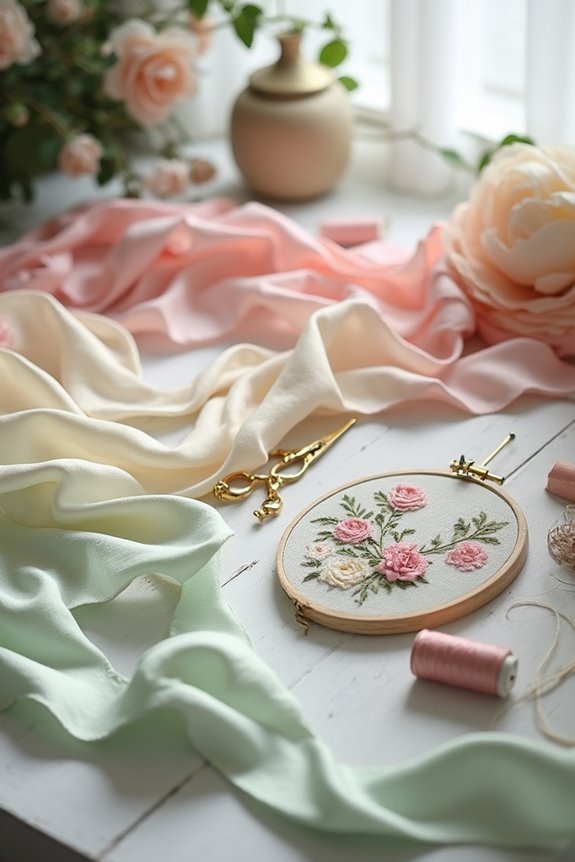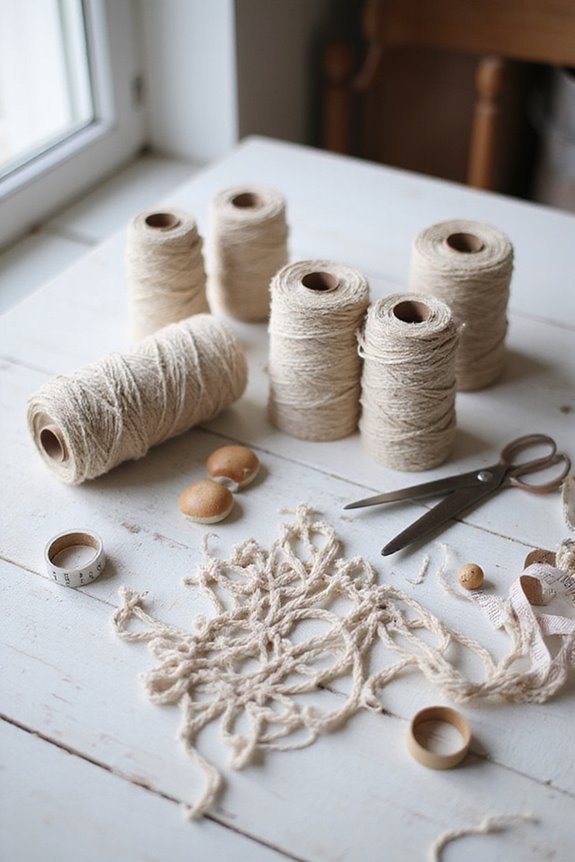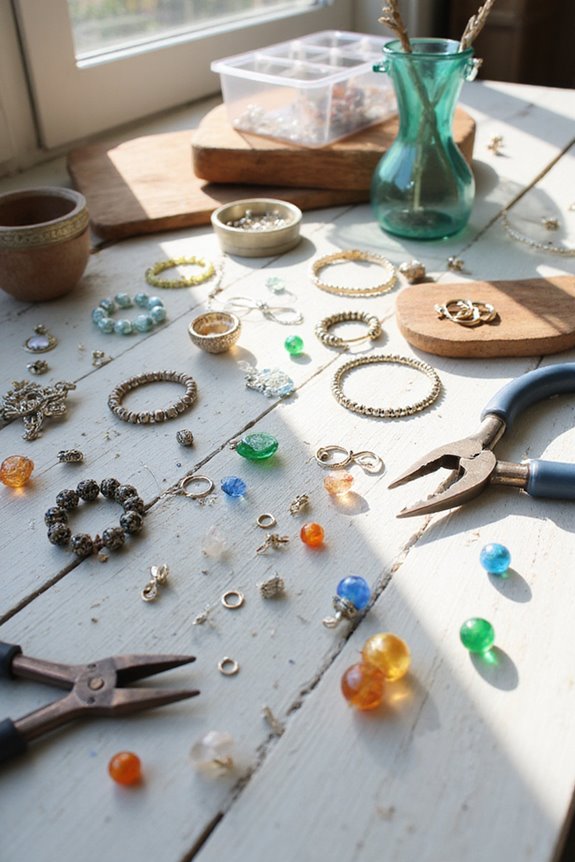To make soap at home safely, we need to understand lye first. Always wear safety goggles and gloves to protect ourselves from splashes. We’ll set up a clean, ventilated workspace, keeping lye away from kids and pets. When mixing, add lye to water slowly and stir gently. Use digital scales for accurate measurements of oils and lye. Remember, safety first! 😊 Stick with us to explore how to combine, cool, and handle accidents properly.
Key Takeaways
- Always wear appropriate PPE, such as goggles, gloves, and long sleeves, to protect against lye splashes and skin contact.
- Prepare a well-ventilated workspace with a sturdy surface, organized supplies, and a safety checklist for spills and first aid.
- Measure lye accurately using a digital scale, always adding lye to water, and stir gently to prevent splashing and heat buildup.
- Ensure all ingredients, including oils and additives, are measured precisely in grams to ensure proper saponification and soap quality.
- Keep children and pets away from the workspace to maintain safety and focus, minimizing the risk of accidents during the soap-making process.
Understanding Lye and Its Properties
Understanding lye is essential for anyone interested in making soap at home. Lye, or sodium hydroxide, is a strong alkali that drives the saponification process—the chemical reaction that turns oils and fats into soap. Accurate lye measurements are vital; too much can lead to harsh soap, while too little may leave unreacted oils.
For safe lye storage, keep it in a cool, dry place, away from moisture to maintain its effectiveness. Remember to always mix lye with water, not the other way around, and do this in a well-ventilated area. Additionally, using high-quality glycerin soap base ensures a smoother and more moisturizing final product.
🧼 Tip: Use a digital scale for precise lye measurements, ensuring your soap turns out just right! Happy soap making!
Essential Personal Protective Equipment (PPE)
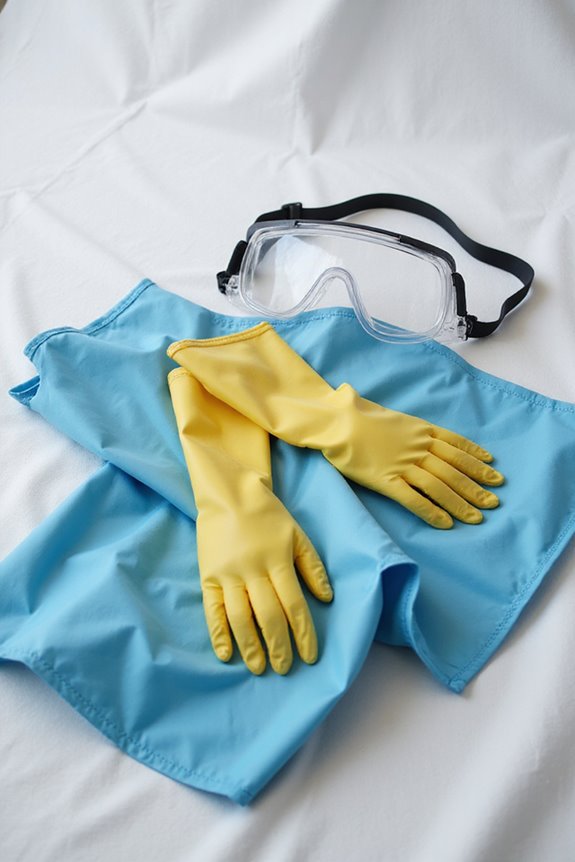
When we immerse ourselves in soap making, prioritizing safety is key. Here’s a quick guide on essential personal protective equipment (PPE) to keep us safe:
- Eye Protection: Always wear snug-fitting safety goggles to guard against lye splashes. Full-face shields offer extra coverage but can limit visibility. ❗
- Glove Types: Choose gloves made from nitrile or rubber, as they resist lye and essential oils. Elbow-length gloves offer more arm protection. Remember, avoid latex if you have allergies! 🧤
- Protective Clothing: Wear long-sleeved shirts and pants, along with a thick, oil-resistant apron. Don’t forget to tie back hair to prevent contamination. Additionally, consider using high glycerin content soap bases for added hydration and comfort during the soap-making process.
Staying safe lets us enjoy the process while keeping accidents at bay!
Setting Up a Safe Soap Making Workspace
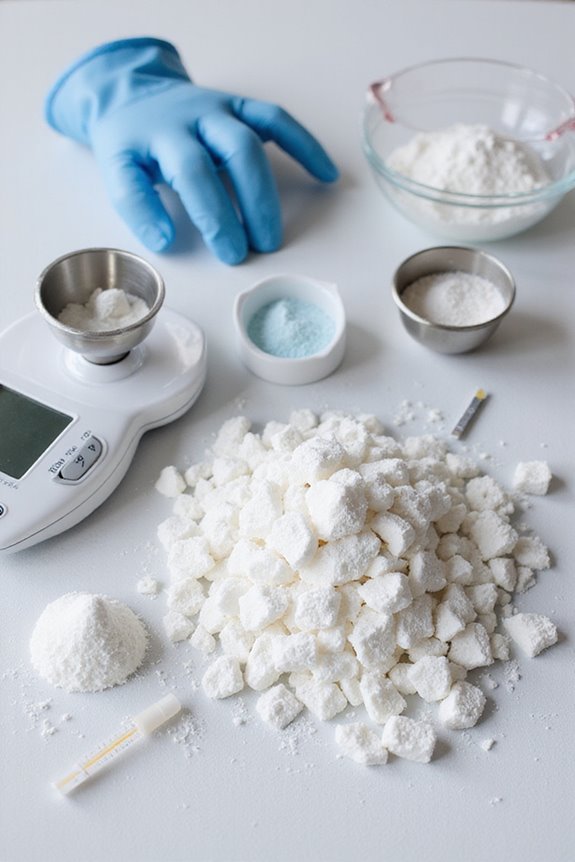
Next, focus on your workspace layout. Use a sturdy, flat surface for your soap making tasks, and keep it clutter-free by organizing supplies on shelves.
Don’t forget to create a safety checklist! Keep paper towels, spill clean-up materials, and a first aid kit nearby for quick access. Label all containers clearly and store hazardous items out of reach to keep everyone safe. 👍 Let’s make soap safely and smoothly! Additionally, ensure that your workspace is well-ventilated to reduce exposure to harmful additives that can affect air quality during the soap-making process.
Safe Techniques for Mixing Lye
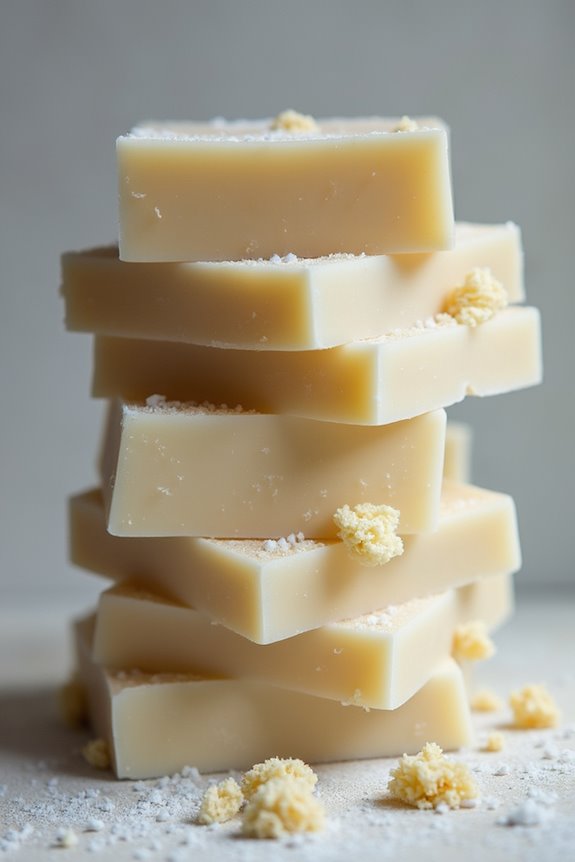
To guarantee our safety while mixing lye, it’s critical that we follow proper techniques and take necessary precautions. 🧤 First and foremost, we should always add lye to water slowly, stirring gently to prevent any dangerous splashing or exothermic reactions.
Here are some key lye safety and mixing techniques to keep in mind:
- Use a large, lye-resistant container to allow for expansion.
- Stir with a heat-resistant spoon until the lye fully dissolves to avoid hot spots.
- Mix in a well-ventilated area, ideally outdoors, to minimize inhaling fumes.
- Keep children and pets away from our workspace to stay focused.
Wearing gloves, goggles, and long clothing protects us from accidental spills. Additionally, using goat milk soap bases can enhance skin benefits while ensuring a moisturizing experience. Let’s prioritize safety!
Properly Measuring Ingredients
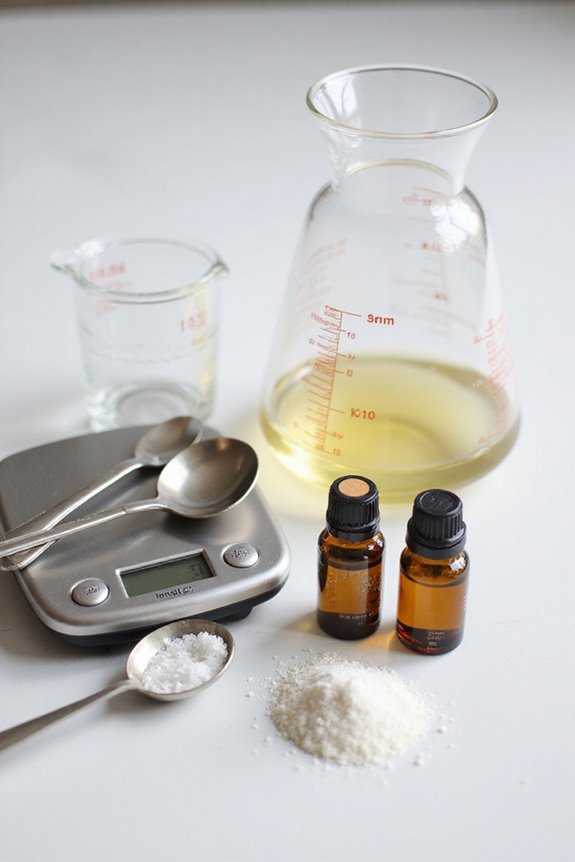
After ensuring our safety while mixing lye, it’s time to focus on another critical aspect of soap making: properly measuring our ingredients. Using digital scales is essential for precise measurements, ensuring the right ratios of oils, lye, and additives.
🔹 Why We Use Digital Scales
They’re way more accurate than measuring cups, which can lead to crumbly or soft soap.
🔹 Metric Units
We should stick to grams for consistency and easier calculations.
🔹 Measuring Oils
Let’s weigh each oil individually—pour liquid oils directly into the scale and melt solid oils first.
🔹 Tare Your Scale
Remember to tare the scale for container weight, and keep our work area clean to avoid contamination. Utilizing acid-free adhesives can also be a crucial consideration for projects involving soap packaging or labeling, ensuring longevity and preservation.
Accuracy is key to making great soap!
Cooling and Combining Lye With Oils
When we combine lye with oils, temperature control is essential for achieving a smooth, balanced soap mixture. We need to confirm both the lye solution and oils are between 100°F and 130°F. This helps prevent uneven saponification. Remember, lye heats up considerably—up to around 200°F—during mixing and must cool down before we combine it with oils.
🔍 Temperature Monitoring Tips:
- Use a reliable thermometer for both the lye solution and oils.
- Gently heat oils that’re solid, like coconut and palm oil, until fully liquid.
Handling Lye Exposure and Accidents
Handling lye safely is essential for anyone diving into soap making. An important step is preventing lye exposure. We should always wear protective gear like gloves, goggles, and long clothing to shield our skin and eyes. If lye makes contact with your skin, rinse it with plenty of water for at least 15 minutes—don’t forget to remove any contaminated clothing!
In case of eye exposure, flush your eyes and seek medical help immediately. For inhalation, move to fresh air; if symptoms persist, consult a doctor. Always have an emergency response plan ready and a well-stocked first aid kit on hand! Remember to keep lye away from children and pets to avoid accidents. Safety first! 🧼✨
Recommended Equipment and Ingredients for Soap Making
To create beautiful, high-quality soap at home, we need the right equipment and ingredients. Here’s a list to guide us:
Essential Tools:
- Measuring spoons for small additives and scents.
- Digital kitchen scale for precise measurements.
- Mixing bowls (large, stainless steel or heat-proof glass) for melting oils and mixing.
- Thermometer to monitor temperatures between 100°F to 160°F.
Ingredients Needed:
- Sodium hydroxide (lye) for soapmaking.
- Oils (like coconut and olive) for nurturing properties.
- Distilled water for lye solutions.
Always remember to wear gloves and goggles for safety. With these tools and ingredients, we’re well-equipped for our soap-making adventure! 🧼✨
Frequently Asked Questions
Can I Use Lye in Other DIY Projects Besides Soap Making?
Absolutely, we can use lye in a variety of DIY projects beyond soap making! Just remember, lye safety’s essential. If we’re cautious, lye alternatives can also help us avoid its caustic nature. Let’s explore!
How Long Can I Store Lye Before It Becomes Ineffective?
Lye storage is essential; it retains its effectiveness for about a year if kept sealed in a dry place. With proper care, like minimizing moisture exposure, we can extend its potency much longer.
What Should I Do if I Spill Lye on My Work Surface?
If we spill lye on our work surface, let’s prioritize lye safety. We should contain the spill, use neutralizing agents, and wear protective gear during cleanup, ensuring a safe environment for ourselves and others.
Is It Safe to Make Soap With Kids Around?
While soap making safety is essential, we can’t safely involve kids in traditional processes. Instead, let’s opt for kid-friendly activities like melt-and-pour soap kits, ensuring everyone has fun without the risks lye poses.
How Do I Safely Dispose of Leftover Lye Solution?
While lye poses risks, we can handle it responsibly. By using lye neutralization methods, we can transform potential hazards into safety. Let’s embrace safe disposal techniques together, ensuring our environment remains clean and protected.

